Parrots can be found across Australia, from the sun-kissed coastlines, to canopies of the rainforest, and right through to the heart of the rugged outback. Their vibrant plumage and enchanting calls, intelligence, and adaptability, make them some of the most easily recognised birds of the avian world.
Globally there are close to 400 species, varying from the one-metre-long Hyacinth Macaw (Anodorhynchus hyacinthinus) of Brazil, to the 8.5cm Buff-faced Pygmy Parrot (Micropsitta pusio) of Indonesia. Of these species, 14% are found here, leading nature documentaries to often refer to Australia as ‘The Land of Parrots’.
Australian parrots can be divided into two types or two families: cockatoos (Cacatuidae family) and true parrots (Psittacidae family). Cockatoos are large, striking birds that typically have white or black plumage and distinctively coloured crests. True parrots are smaller and usually very colourful – among the most colourful birds in the country.
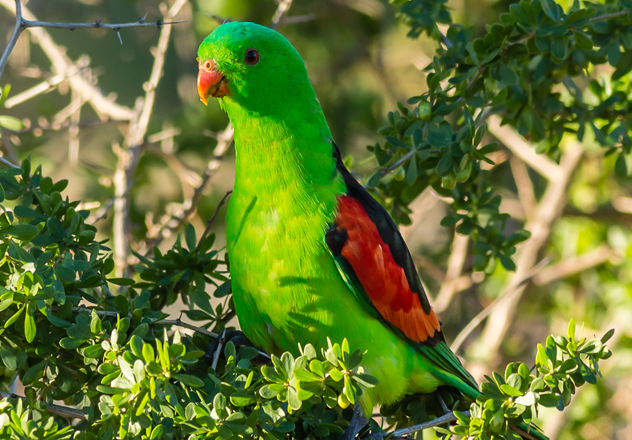 David Jones/AWC
David Jones/AWC
Unique from head to toe
Australian parrots are easily identified by their robust bills, which curve deeply downward. The upper part of their bill is mobile, while the lower part fits neatly within the closed bill and has limited movement. This unique oral structure enables parrots to deftly manipulate seeds with their upper beak and flexible tongue, securely holding nut casings in their bottom jaw, sometimes aided by their adept claws.
Additionally, the feet of parrots are distinctive within the avian world. Their toes are arranged in a “zygodactylous” manner, with two toes pointing forward and two pointing backwards. This configuration grants the parrot remarkable agility in treetops. Each toe ends in a long, sharply curved claw, providing birds with an exceptionally strong grip for climbing tree trunks and seizing slippery nuts and seedpods.
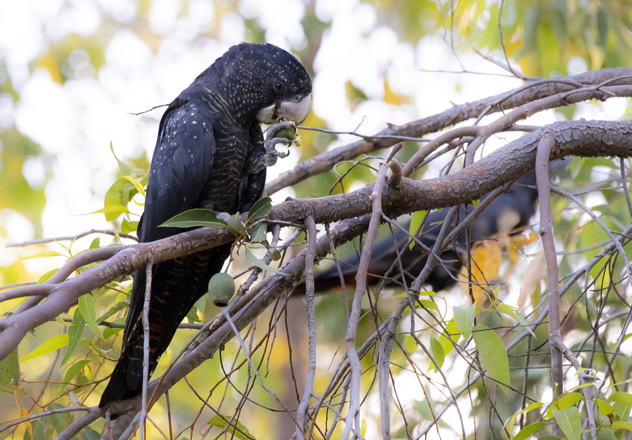 Brad Leue/AWC
Brad Leue/AWC
Heart and home
Many parrots and cockatoos form lifelong pair bonds, reaffirming their connection through mutual grooming and “courtship feeding”, where the male presents his mate with food offerings during the breeding season.
Nests are typically nestled deep within tree hollows, often within the expansive boughs on the trunk. These nests are carefully lined with combinations of eucalypt bark chips, gum leaves, or shredded twigs, providing insulation and protection for eggs and hatchlings.
However, exceptions to this nesting behaviour exist among ground-dwelling species such as the Night Parrot, the Ground Parrots, and the Rock Parrot. The Rock Parrot forgoes traditional nest-building altogether, opting to lay eggs in a shallow indentation on rocky ledges or coastal cliff faces.
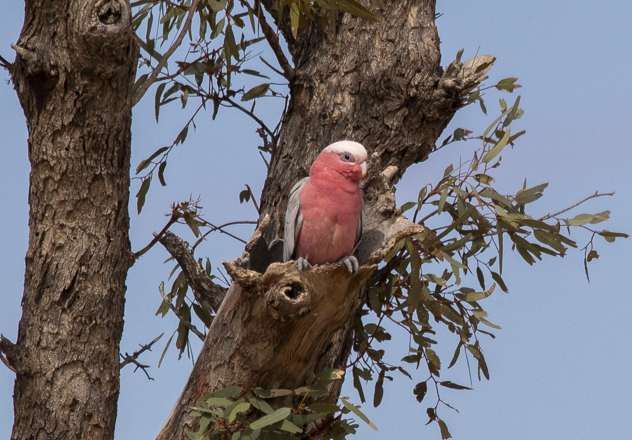 Brad Leue/AWC
Brad Leue/AWC
Here are some parrot species found on AWC sanctuaries and partnership areas.
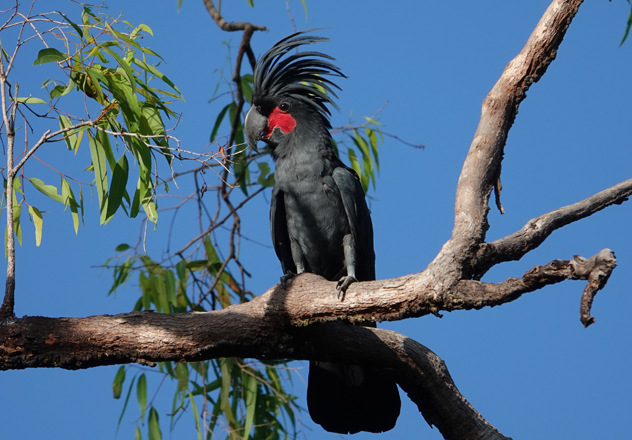 Helena Stokes/AWC
Helena Stokes/AWC
Palm Cockatoo (Probosciger aterrimus)
Conservation status: Endangered
Australia’s largest parrot, growing up to 60 cm in length, is justifiably famous as one of the few non-human animals to craft tools for sound – creating drumsticks to make a rhythmic beat.
It is a distinctive bird with glossy smokey-grey-to-black feathers, a large crest, and one of the largest bills of any parrot. The Palm Cockatoo also has distinctive red cheek patches that change colour when the bird is alarmed or excited.
The species is under threat due to losing habitat from poor fire management and ongoing land-clearing. It is particularly vulnerable to threats due to its extremely low breeding rates, with females laying a single egg every two years.
Of the offspring, only 23% of their chicks live until they fledge. Meaning, on average, each breeding pair successfully raises just one chick every 10 years.
The species can be found on Piccaninny Plains Wildlife Sanctuary, in the heart of Cape York Peninsula, where AWC’s fire management program is helping to protect vital breeding grounds.
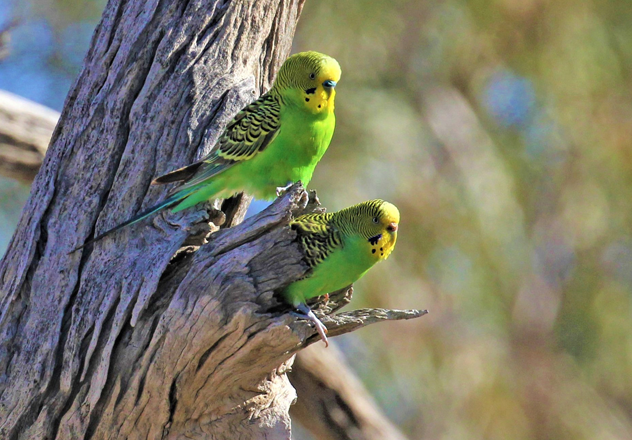 Peter Haines/AWC
Peter Haines/AWC
Budgerigar (Melopsittacus undulatus)
Conservation status: Least concern
Found in the drier parts of Australia, “Budgies” are the most easily recognised species of Australian parrot. They grow to a length of 18 cm and have bright yellow and green plumage, blue cheeks and black scalloping on their wing feathers. They are often spotted in small flocks that can increase enormously during favourable conditions.
Their success can be attributed to a nomadic lifestyle and their ability to breed while on the move. They generally fly north during winter, covering significant distances as they migrate, following rainfall and seasonally abundant seeding grasses.
While abundant, the species are highly susceptible to predation from feral cats and altered food sources, with introduced pasture grasses such as buffel and love grass replacing native species across their range.
Budgies can be found at almost all AWC sanctuaries and partnership areas where our science-informed feral predator and land management programs create ideal habitats.
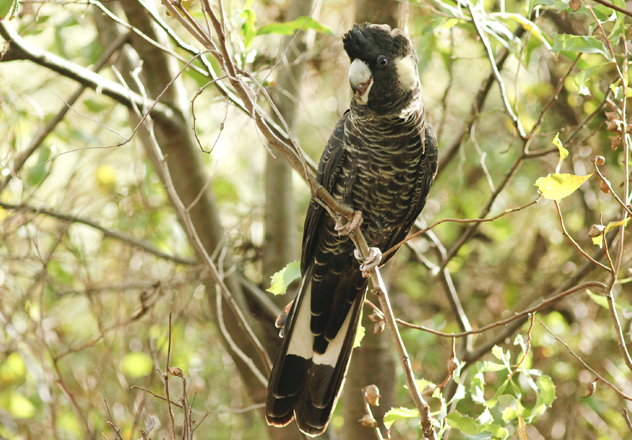 Wayne Lawler/AWC
Wayne Lawler/AWC
Carnaby’s Black Cockatoo (Calyptorhynchus latirostris)
Conservation status: Endangered
Endemic to southwest Western Australia, mostly within the Wheatbelt region, Carnaby’s Black Cockatoo can be found in woodlands and scrubs.
Growing to between 53-58 cm in length the species is mostly greyish black, with a white tail band and white margins on the tips of dark feathers, giving it a scalloped appearance.
The biggest threat to Carnaby’s Black Cockatoo is habitat loss. Large-scale clearing for agriculture in the Western Australian Wheatbelt has removed or fragmented much of the bird’s breeding habitat.
Feeding habitat is also being degraded and lost by ongoing clearing for urban development on the Swan Coastal Plain, where 54% of its habitat —an important area outside the breeding season—has been lost.
Carnaby’s Black Cockatoos can be found on both AWC’s Paruna and Karakamia Wildlife sanctuaries, where old-growth trees provide ideal breeding hollows.
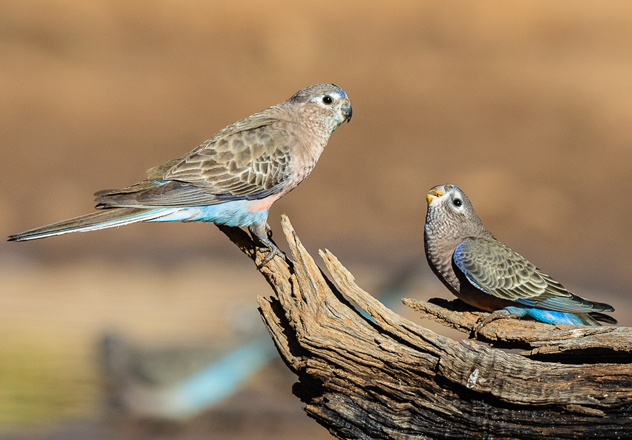 David Jones/AWC
David Jones/AWC
Bourke’s Parrot (Neopsephotus bourkii)
Conservation status: Least concern
Bourke’s Parrot is a small parrot which grows to between 18 and 23 cm in length. They are mostly grey-brown above and pinkish below with blue on the flanks, side of the rump and under the tail. A prominent area of white around the eyes gives a spectacled appearance.
Widespread across arid and semi-arid areas of the inland, movements of Bourke’s Parrot are not well-known. Although thought to be nomadic, they are likely resident in some areas.
The main threats to this species are predation from red foxes and feral cats. Drought, overstocking, rabbits and degradation of watering holes can have significant impacts on the population.
Bourke’s Parrot can be found on several AWC sanctuaries, including Bowra in outback Queenland, Newhaven and Ngalarrtju in central Australia, and Kalamurina in arid South Australia.
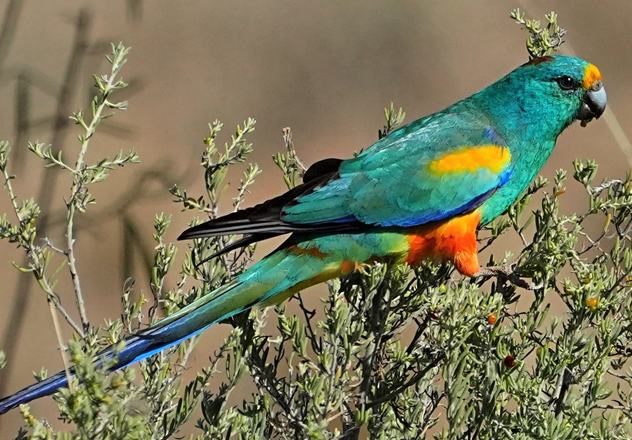
Mulga Parrot (Psephotellus varius)
Conservation status: Least concern
Although the species does occur throughout mulga habitats, Mulga Parrot is a bit of a misnomer, as they are also found in arid scrublands and lightly timbered grasslands in the interior of southern Australia.
Growing to 32 cm in length this species is sexually dimorphic, differing markedly in plumage. The male (pictured here) is vividly coloured, females however are drabber in comparison, being an olive-green with washed-out yellows and greens.
Mulga Parrots live in permanent territories as pairs, joining together in small groups only at food sources or when visiting water.
As with other woodland bird species, the main threat to the Mulga Parrot is the loss of habitat, feeding grounds, and water availability.
They can be found on several AWC sanctuaries, including Buckaringa in South Australia, Mt Gibson in Western Australia, and the Pilliga conservation area in New South Wales.
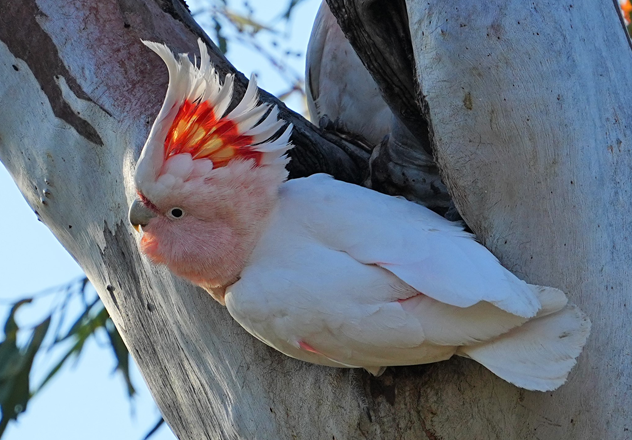 Cameron Whiley/AWC
Cameron Whiley/AWC
Pink Cockatoo (Lophochroa leadbeateri)
Conservation status: Endangered
The Pink Cockatoo is medium-sized, growing to about 40 cm long. They have soft-textured white and salmon-pink plumage, though the most prominent feature is the large, white-tipped crest, banded in red and gold.
They live mostly in semi-arid and arid areas, in dry woodlands, particularly mallee, and may live in much the same area all year round if there is sufficient water. They can be partly nomadic in arid zones, moving in response to the availability of food and water.
Their range and numbers have been reduced due to land clearing and extensive or frequent fires, which has decreased the availability of nesting hollows.
At AWC’s Bowra Wildlife Sanctuary, ornithologists from the Queensland University of Technology are studying Pink Cockatoos using AI and bioacoustics to learn more about their breeding activity and ecology.
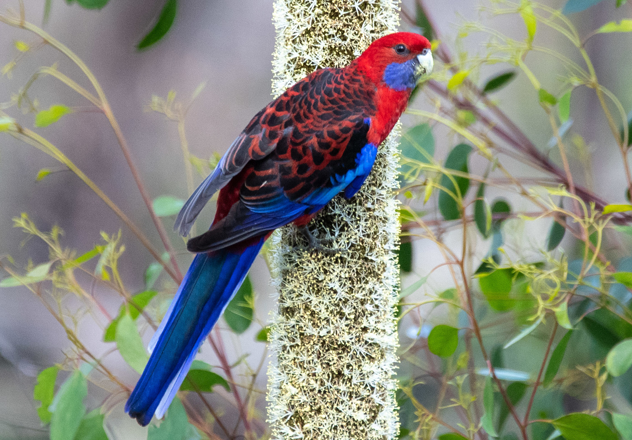 Brad Leue/AWC
Brad Leue/AWC
Crimson Rosella (Platycercus elegans)
Conservation status: Least concern
Crimson Rosellas are not only red, but can also be yellow or orange, the orange is a result of breeding between yellow and red birds.
The form it is named for has mostly crimson plumage and bright blue cheeks and tail, with the feathers of the back and wings black, broadly edged with red. They grow to 36 cm in length and are native to eastern and south-eastern Australia, commonly associated with tall eucalypt and wetter forests.
The species are usually encountered in twos or threes but may occur in much larger groups and feed mainly on tree seeds – though they also forage for berries, nuts and insects.
The Crimson Rosella is classified as a species of “Least Concern” on the IUCN Red List, however, like many bird species they face threats from habitat loss and fragmentation and introduced predators such as cats and foxes.
Threats to parrots
Like many Australian species, parrots face numerous threats. Habitat loss and degradation, changed fire regimes, introduced predators such as cats and foxes, and increasing climate change pose significant challenges to their populations, pushing some species perilously close to extinction.
Most parrots need old trees that have developed hollows to nest in. Good-sized hollow-bearing trees are usually over 100 years old (or more) and are normally only found in ‘old-growth’ vegetation. Some parrot species are in decline due to the loss of old-growth forests, particularly in agricultural regions. Across northern Australia, however, the primary threat is from wildfires.
Illegal trapping and smuggling operations of live birds may also have contributed to the decrease in Australian parrot populations.
Your support can help AWC continue to provide sanctuary for Australian parrots
Donate now